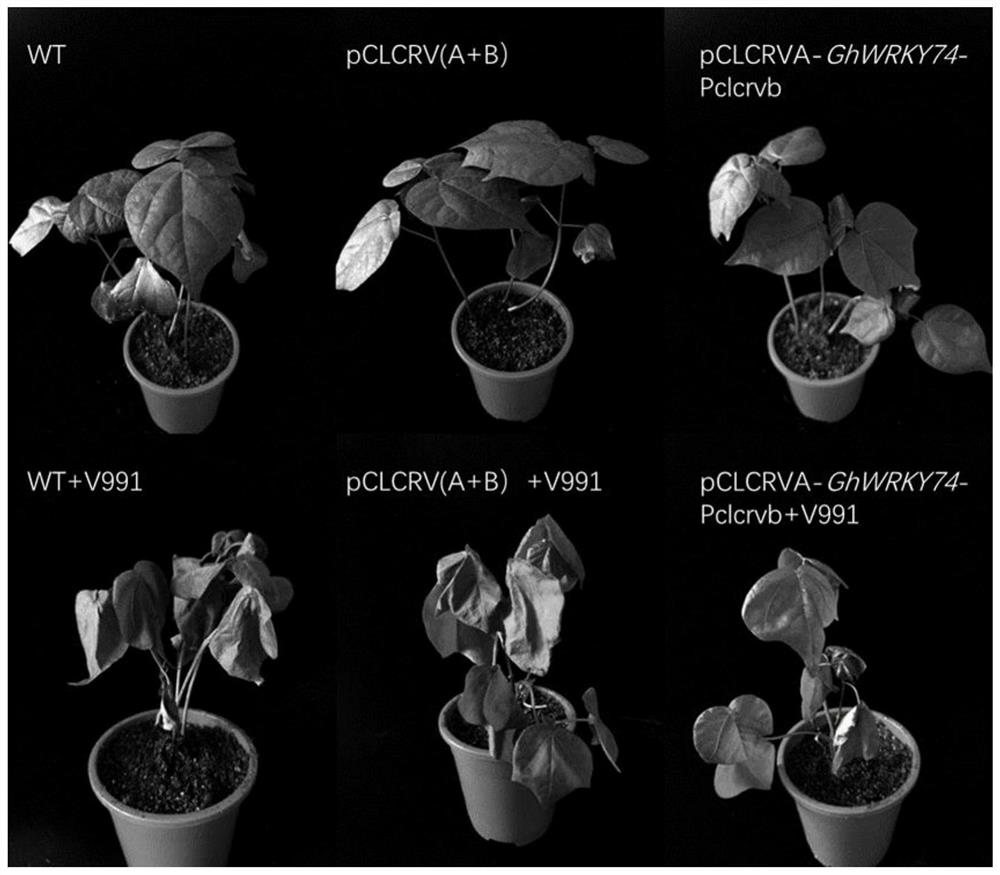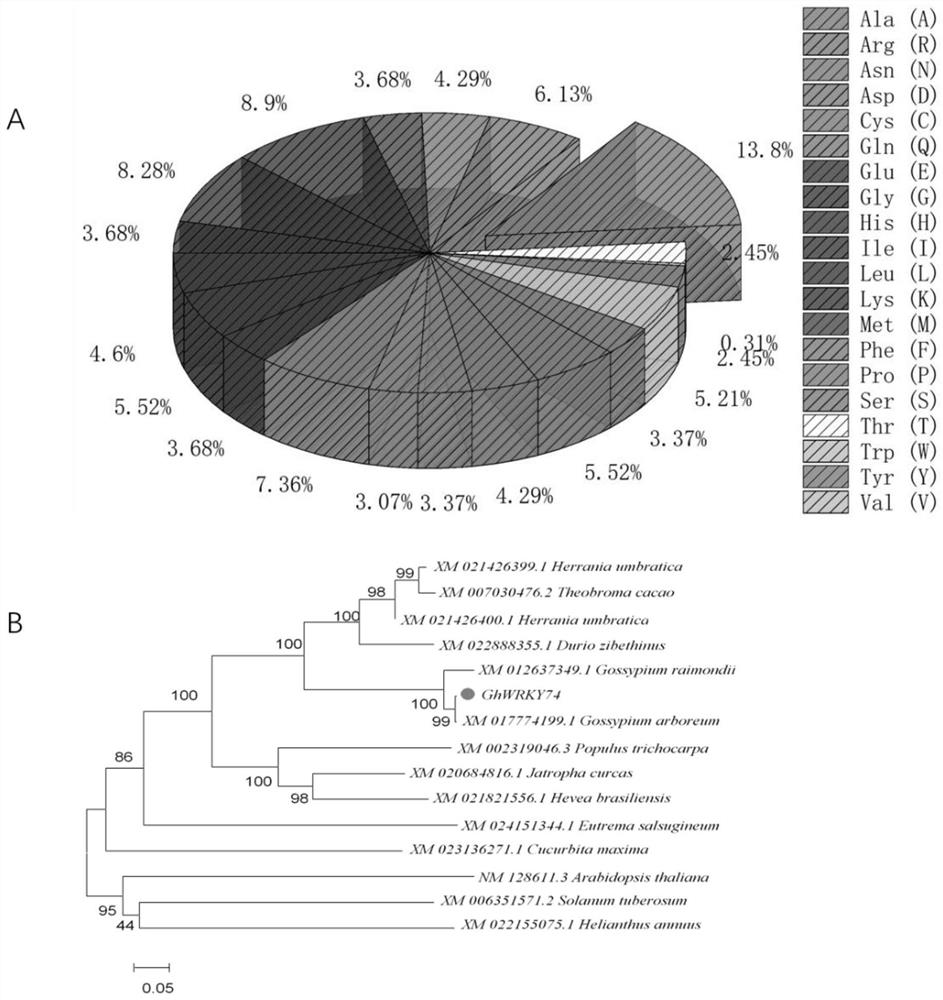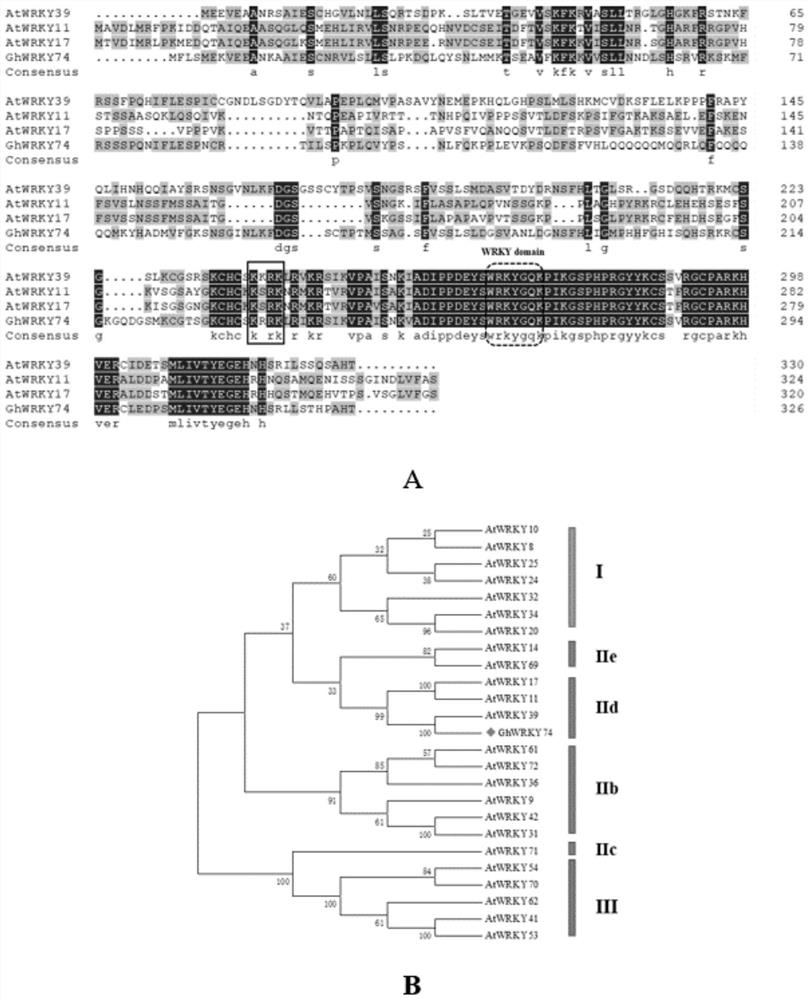Upland cotton ghwrky74 protein and its encoding gene and application
A kind of upland cotton, gene technology, applied in the field of molecular biology
- Summary
- Abstract
- Description
- Claims
- Application Information
AI Technical Summary
Problems solved by technology
Method used
Image
Examples
Embodiment 1
[0028] Example 1 Cloning of Verticillium wilt-related gene GhWRKY74 in upland cotton
[0029] Cloning the Verticillium wilt-related gene GhWRKY74 of upland cotton comprises the following steps:
[0030] 1. Extraction of RNA
[0031] RNA from cotton variety 86-1 leaf samples were extracted using RNAprep Pure Plant Polyphenol Polysaccharide Total RNA Extraction Kit.
[0032] 2. Synthesis of cDNA
[0033] 2.1 Synthesis of intermediate fragment cDNA
[0034] The cDNA of the intermediate fragment was synthesized using the FastQuant cDNA First Strand Synthesis Kit to reverse transcribe the cDNA.
[0035] 2.2 Synthesis of cDNA at the 3' end
[0036] The synthesis system of cDNA at the 3' end is shown in Table 1 below:
[0037] Table 1
[0038]
[0039] Mix according to the above system, after centrifugation, place on PCR instrument at 42°C for 60 minutes, and at 70°C for 15 minutes, cool on ice after the reaction, and store at -20°C.
[0040] 2.3 Synthesis of cDNA at the 5'...
Embodiment 2
[0111] Example 2 Bioinformatic analysis of GhWRKY74 protein
[0112] According to the prediction of the online tool ProtParam, the molecular weight of the protein is 36.82626kDa, the isoelectric point is 9.80, and the molecular formula is C 1606 h 2564 N 478O472 S 22 The instability index is 56.41, which belongs to unstable protein; the total average hydrophilicity-0.653, belongs to hydrophilic protein; 20 kinds of amino acids constituting protein, serine (Ser) accounts for the highest ratio (13.8%) (such as figure 2 Shown in A), containing 23 negatively charged amino acid residues and 47 positively charged amino acid residues.
[0113] SignalP 4.0 was used to predict that the protein had no signal peptide; TMHMM Server v.2.0 predicted that the protein had no transmembrane helical region; CDD predicted that the protein had zinc finger domain and WRKY domain.
[0114] Through multiple sequence alignment and application of MEGA software, the phylogenetic tree of GhWRKY74 wa...
Embodiment 3
[0116] Example 3 Analysis of the expression level of GhWRKY74 in different tissues of cotton susceptible variety 86-1
[0117] 3.1 Experimental method:
[0118] When Upland Cotton 86-1 was cultivated until two true leaves unfolded, the roots, stems and leaves of the cotton were harvested, thoroughly cleaned and surface sterilized, frozen in liquid nitrogen and stored in a -80°C ultra-low temperature refrigerator.
[0119] RNAprep Pure plant polyphenol polysaccharide total RNA extraction kit was used to extract RNA from different cotton tissue samples, and FastQuant cDNA first-strand synthesis kit was used to reverse transcribe cDNA, and the expression of GhWRKY74 gene in different tissues was determined after reverse transcription. (All kits were purchased from Beijing Tiangen)
[0120] 3.2 Experimental results:
[0121] By extracting RNA from different tissues of roots, stems, and leaves of cotton susceptible varieties, it was confirmed by RT-PCR that it was expressed in ro...
PUM
| Property | Measurement | Unit |
|---|---|---|
| molecular weight | aaaaa | aaaaa |
Abstract
Description
Claims
Application Information
 Login to View More
Login to View More - R&D
- Intellectual Property
- Life Sciences
- Materials
- Tech Scout
- Unparalleled Data Quality
- Higher Quality Content
- 60% Fewer Hallucinations
Browse by: Latest US Patents, China's latest patents, Technical Efficacy Thesaurus, Application Domain, Technology Topic, Popular Technical Reports.
© 2025 PatSnap. All rights reserved.Legal|Privacy policy|Modern Slavery Act Transparency Statement|Sitemap|About US| Contact US: help@patsnap.com



